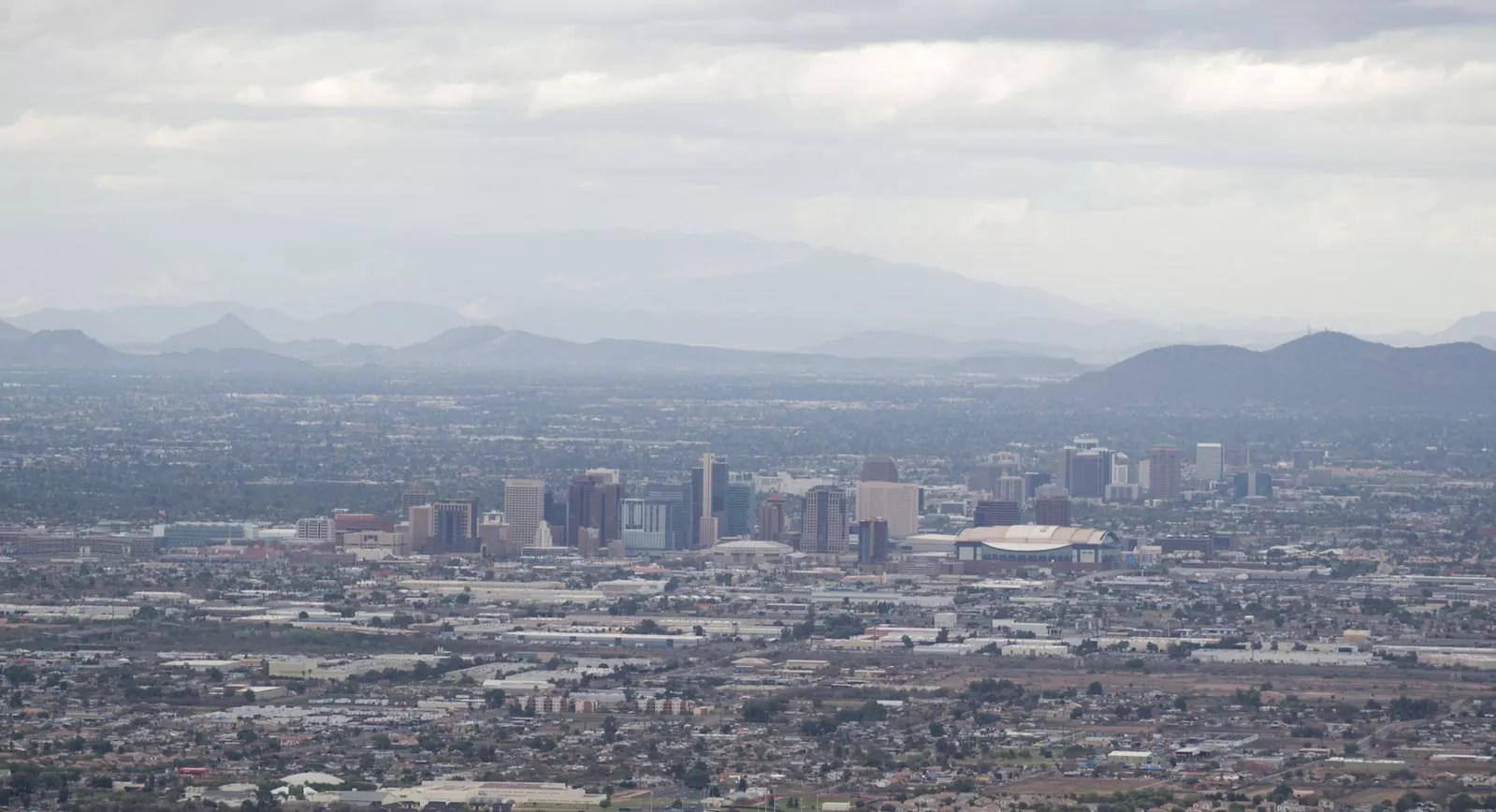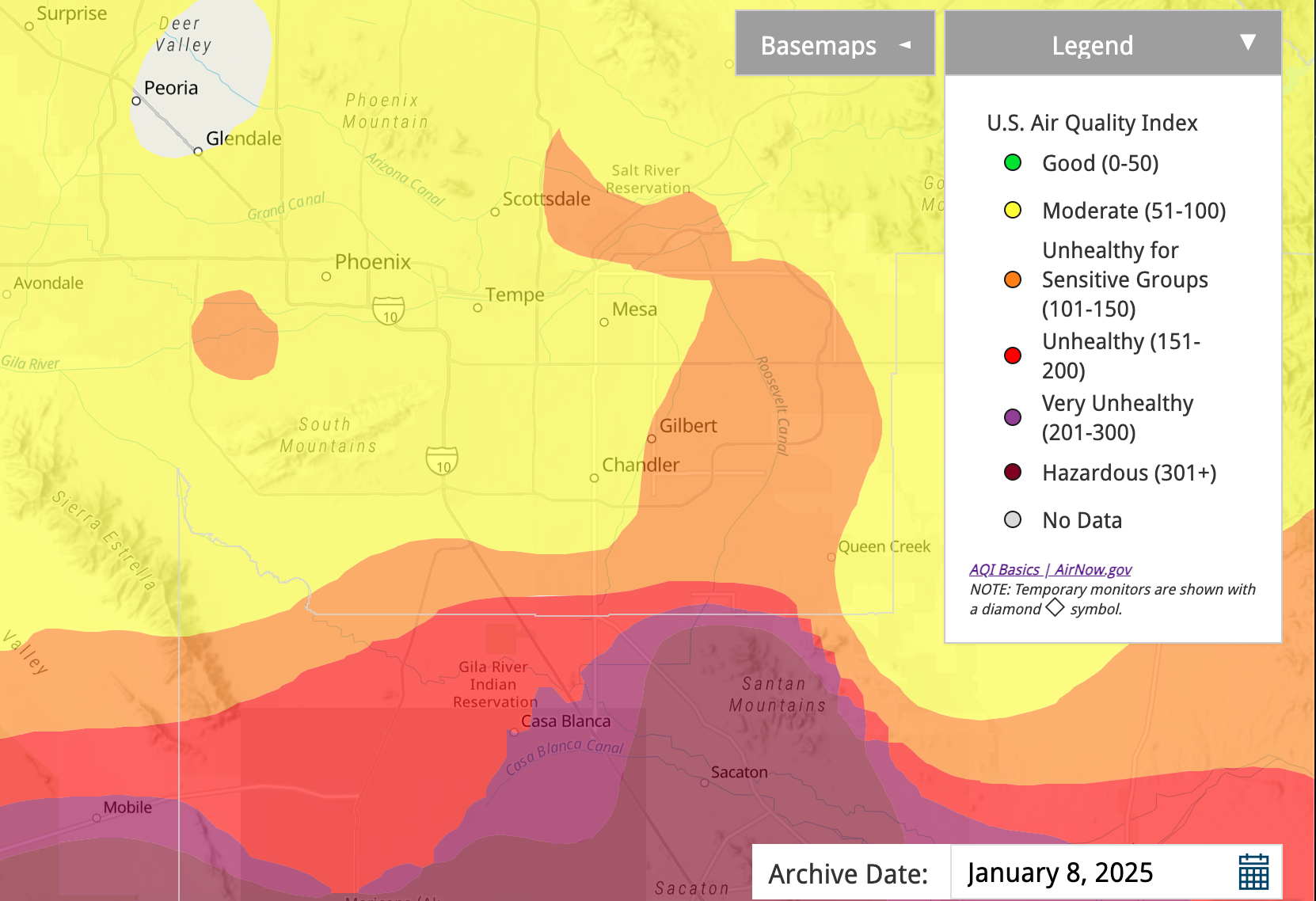
Don Barrett/Flickr

Audio By Carbonatix
Flames have engulfed large parts of Los Angeles, and some Arizona locals have speculated that winds are pushing the smoke east and befouling the air in Phoenix. While wildfire smoke has certainly affected Phoenix air on numerous occasions, that’s not true this time, according to the Arizona Department of Environmental Quality.
“We want you to know: the haze you’re seeing over the Valley is dust from our region, not smoke” from the Los Angeles fires, the department tweeted on Thursday. California’s wildfire smoke is being blown over the Pacific Ocean.
Even so, air quality has been poor so far in 2025.
“It’s been a rough start for us this year in terms of air quality,” said Brody Droppleman, a meteorologist at the Department of Environmental Quality.
Will you step up to support New Times this year?
At New Times, we’re small and scrappy — and we make the most of every dollar from our supporters. Right now, we’re $15,500 away from reaching our December 31 goal of $30,000. If you’ve ever learned something new, stayed informed, or felt more connected because of New Times, now’s the time to give back.
Here’s why.
How bad has Phoenix air quality been?
The quality of air is measured by the Environmental Protection Agency – as well as statewide agencies – using an Air Quality Index, or AQI. It’s a tool that gives you a pretty good idea of what’s going on and how you should probably respond depending on your health factors.
An AQI generally features six color-coded categories of air quality – Good, Moderate, Unhealthy for Sensitive Groups, Unhealthy, Very Unhealthy and Hazardous – with more details on the severity of conditions and what precautionary measures are encouraged by category.
For much of the week, Phoenix has been in the moderate category, but parts of the Valley such as the San Tan Mountains saw Very Unhealthy conditions on Wednesday, according to the EPA.

The Air Quality Index in the Valley on Jan. 8.
AirNow.gov
The Air Quality Index in the Valley on Jan. 1. AirNow.gov
On New Year’s Day, AQI levels were high all over town.
Why did the year start so hazy in Phoenix?
Waking up on New Year’s Day, Phoenix residents were greeted by a thick gray haze blanketing the Valley thanks to fireworks set off across town. According to the department, Phoenix saw its highest smoke levels since 2010 following New Year’s Eve festivities. Droppleman said it hung around the Valley for a few days.
Oh wow. The air quality in Phoenix right now. 😷 #azwx #azfamily pic.twitter.com/BjCINecPDf
— Ian Schwartz (@SchwartzTV) January 1, 2025
“That is partly because it was so calm and it’s been so dry, so that did worsen the smoke a fair bit,” Droppleman said. “We have still approached those levels quite frequently on New Year’s Day because of fireworks. If it doesn’t rain, we just about see it every time.”
Will Humble, executive director of the nonprofit Arizona Public Health Association, noted the extremely hazardous air quality in a tweet and mentioned that aerobic exercise “will do more harm than good today.”
Air quality is off-the-charts bad this am. Aerobic exercise will do more harm than good today
— Will Humble 🌠(@willhumble_az) January 1, 2025
Todays air quality is a direct result of ARS 36-1606, prohibiting local jurisdictions from regulating fireworks use last night âž¡ï¸https://t.co/h5JbQUyIPX
Levelsâž¡ï¸https://t.co/bbgbi9kuoR pic.twitter.com/caXfWjBMbI
While Doppleman noted fireworks were the main cause of that smoke, he said people burning wood, as in firepits, also contributed. And even while smoke concentration levels were really high this year, they typically approach such a level most years.
“If we don’t have any rain or any storm system moving through, and it’s dry and the winds are calm, it’s almost certain that we will exceed the public health standard,” Droppleman said.
Did anything else affect air quality in Phoenix?
While the New Year’s smoke stuck around Phoenix for a few days – call it hangover pollution- its particles eventually cleared out. But another weather event was around the corner to shake things up.
Over the last few days, Droppleman said, dust accumulated in the desert has been blowing all across the state. On Jan. 8, the quality of air over southwestern Arizona was considered Very Unhealthy by the EPA and nearly reached Hazardous.
“If you take away that blowing dust event, the trends of air quality have been fairly typical. It’s just been worsened because every now and then, we’ll get these systems moving through, and also it’s just been so dry,” Droppleman said. “Of course, we live in the desert, but we’re on a long streak here in Phoenix without rain, and that’s made things a little bit worse.”
The Department of Environmental Quality’s forecast currently predicts air quality will mostly remain at Moderate levels in the next five days, potentially veering into Unhealthy territory on Monday and Tuesday.